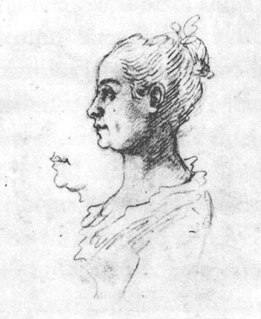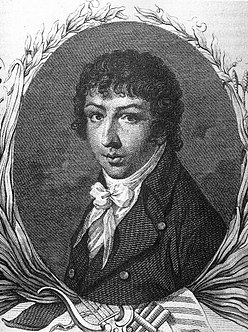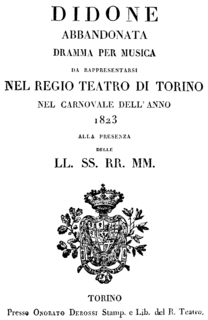
Niccolò Jommelli was an Italian composer of the Neapolitan School. Along with other composers mainly in the Holy Roman Empire and France, he was responsible for certain operatic reforms including reducing ornateness of style and the primacy of star singers somewhat.
Domenico Natale Sarro, also Sarri was an Italian composer.

Didone abbandonata is an opera libretto in three acts by Pietro Metastasio. It was his first original work and was set to music by Domenico Sarro in 1724. The opera was accompanied by the intermezzo L'impresario delle Isole Canarie, also by Metastasio.

Joseph Schuster was a German composer.
Francesco Zoppis was an Italian composer.
Gennaro Astarita was an Italian composer, mainly of operas. The place of his birth is unknown, although he was active in Naples for many years. He began his operatic career in 1765, collaborating with Niccolò Piccinni in the writing of the opera L'orfana insidiata. He became the maestro di cappella in Naples in 1770.
Rinaldo di (da) Capua was an Italian composer. Little is known of him with any certainty, including his name, although he was known to Charles Burney. He may have been the father of composer Marcello Bernardini.

Didone abbandonata was an opera in three acts composed by Tomaso Albinoni. Albinoni's music was set to Pietro Metastasio's libretto, Didone abbandonata, which was in turn based on the story of Dido and Aeneas from the fourth book of Virgil's Aeneid. The opera premiered on 26 December 1724 at the Teatro San Cassiano in Venice and was the first time that an opera based on a Metastasio libretto was performed in Venice.

Dido, Queen of Carthage was an opera in three acts by Stephen Storace. Its English libretto by Prince Hoare was adapted from Metastasio's 1724 libretto, Didone abbandonata, which had been set by many composers. Storace's opera premiered on 23 May 1792 at The King's Theatre in London combined with a performance of his masque, Neptune's Prophecy. The story is based on that of Dido and Aeneas in the fourth book of Virgil's Aeneid. The opera was not a success and was never revived after its original run of performances. The score has been lost.

Didone abbandonata is an opera in three acts composed by Domenico Sarro to a libretto by Pietro Metastasio of the same name which was based on the story of Dido and Aeneas from the fourth book of Virgil's Aeneid. The opera premiered on 1 February 1724 at the Teatro San Bartolomeo in Naples.
Andrea Adolfati was an Italian composer who is particularly remembered for his output of opera serias. His works are generally conventional and stylistically similar to the operas of his teacher Baldassare Galuppi. Although his music largely followed the fashion of his time, he did compose two tunes with unusual time signatures for his day: an air in 5
4 meter and another in 7
4 meter.
Pietro Chiarini was an Italian composer.

L'impresario delle Isole Canarie, also known as L'impresario delle Canarie or Dorina e Nibbio, is a satirical opera intermezzo libretto attributed to Metastasio, written in 1724 to be performed between the acts of Metastasio's opera seria Didone abbandonata. The first performance of the work was on February 1, 1724 in Naples, Italy, at Teatro San Bartolomeo. The first composer to set this libretto to music was Domenico Sarro, also known by the name Sarri, who also revised the work in 1730. The role of Dorina was first sung by the contralto Santa Marchesini, and Nibbio by the basso buffo singer Gioacchino Corrado. Later versions of this libretto appear with the titles L'impresario, L'impresario e la cantante and others.
Didone abbandonata is a libretto by Metastasio
Didone abbandonata is a setting by Leonardo Vinci of the libretto Didone abbandonata by Metastasio first set to music by Domenico Sarro in 1724. It was premiered at the Teatro delle Dame for the 1726 Carnival season in Rome.
Didone abbandonata is a 1742 opera by Johann Adolph Hasse setting the libretto Didone abbandonata by Metastasio. It was first performed at Hubertusburg palace, near Dresden.
Didone Abbandonata - Piano Sonata in G, Op. 50, No.3 is the final sonata composed by Muzio Clementi in 1821. It was titled after Metastasio's often-set opera libretto of the same name, and Clementi seeks to tell the tragic story of Virgil's heroine instrumentally. It is the only example of such a programmatic piece in the composer's oeuvre.
Didone abbandonata is an opera in three acts by Niccolò Jommelli of the libretto Didone abbandonata by Pietro Metastasio. It was composed just after Jommelli left Venice in 1746 and revised in 1763. It was first performed on January 28, 1747 at the Teatro Argentina in Rome.
Didone abbandonata is a 1740 setting by Baldassare Galuppi of the libretto of the same name by Metastasio.

Didone abbandonata is an 1823 opera in two acts by Saverio Mercadante to a libretto by Andrea Leone Tottola after Metastasio's Didone abbandonata. It was first performed on 18 January 1823 at the Teatro Regio in Turin.








